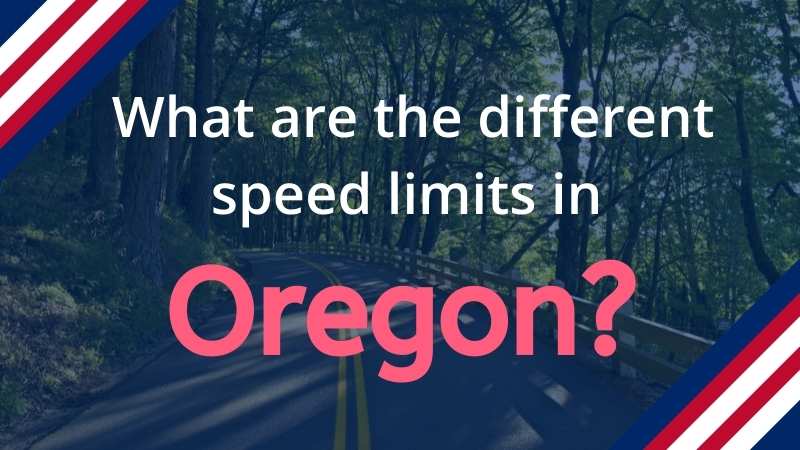Speed limits and the laws attached to them are most definitely not the first things that spring to mind when traveling to or through such a beautiful state as Oregon. However, it is perhaps one of the most important things to familiarize yourself with.
The state’s traffic authority in Oregon sets out clear guidelines that must be followed in order to avoid receiving a traffic ticket, license points, subsequent insurance increases, and even jail time!
If you are moving to Oregon from another state, visiting or relocating from another country, or simply driving through the state, knowing what the correct speed limits are in Oregon is so incredibly important.

Knowledge of the correct speed limits is not only about avoiding punishment. It is also about driving safely on the roads to prevent accidents with other motorists. Driving within the speed limit helps reduce the possibility of crashes and promotes efficient use of the road.
Traffic laws, including speed limits and other motor vehicle-related laws, are established by the Oregon Department of Transportation. The state speed limits are defined by two different types of speed limits, basic speeding Oregon law, and absolute speed limits.
The basic speeding law prohibits driving “at a speed greater than is reasonable and prudent under the conditions and having regard to the actual hazards then existing”. This basically means that motorists must always drive at a safe speed for the conditions and environment they are driving in.
An example would be that if you were driving on a 60 mph road on a windy, dark, and icy evening, you would be required to slow down your speed to significantly less than the signed speed limit of 60 mph. This is because the weather and road conditions would be considered dangerous, and if you were caught driving at the signed limit, you may be slapped with fines and potentially worse punishments.
Oregon Speed Limit Laws
The absolute speed limit in Oregon is the speed limit you see signposted on roadways, literally what you see is what you get. If the weather conditions are good, the roads are clear and safe, you may go at the maximum speed limit. Surpassing it will likely cost you fines, and other penalties.
Oregon certainly does not have the highest maximum speed limit in the U.S., in fact, there are a total of 16 other states that all have a higher maximum speed limit. The maximum speed limit at which you can travel on specific roads in Oregon is 70 mph.
Here are the different speed limits to look out for in Oregon:
- 25 mph is the speed limit in residential areas (always double-check the posted speed limit).
- 70 mph is the maximum speed limit for undivided roads.
- 70 mph is the maximum speed limit for divided roads.
- The urban highway speed limit in Oregon is 60 mph.
- Rural highways in Oregon are 70 mph.
- What is the highest speed limit in Oregon? Interstate highways and rural interstates in Oregon are 70 mph, trucks that drive on an interstate highway must abide by a specific truck limit of 65 mph too (truck speed limit Oregon).
When driving through residential areas and not a state highway, something to be aware of is schools, hospitals, and construction zones as these areas often have temporarily lowered speed limits and enforce these limits very strictly. You don’t want to receive a lofty fine for not being aware of this.
Truck Speed Limit Oregon
In Oregon, the cost of the speeding ticket depends on where the speeding violation took place, in addition to how quickly you were going (how much you surpassed the signed speed limit), here are the different speeding fines:
- If you drive 1-10 mph over the limit this will count as a class D traffic violation which is a mandatory fine of $115, and $225 if you committed the offense in a school or construction zone.
- If you drive 11-20 mph over the limit this will count as a class C traffic violation which is a mandatory fine of $165, and $325 if you committed the offense in a school or construction zone.
- If you drive 21-30 mph over the limit this will count as a class B traffic violation which is a mandatory fine of $265, and $525 if committed in a school or construction zone.
- If you drive 30 mph over the limit this will count as a class A traffic violation which is a mandatory fine of $440, and $875 if committed in a school or construction zone. In addition to these fines, you may also have your license suspended for up to 30 days if you have committed a speeding violation prior to this one within the last year.
- If you surpass the speed limit by 100 mph or more you will be slapped with a fine of $1,150 and will receive a mandatory license suspension for 90 days (or more).
Unlike many other states, Oregon does not invoke a point system, however, the state does record each speeding violation onto your driving record. It is simple – if you accumulate too many moving violations, the state will suspend your license, and if it carries on, expect to receive even harsher penalties.
When visiting, vacationing, or even relocating to the beautiful state of Oregon, it is understandable to have your mind focused on fun and awesome things to do and places to see. However, knowledge of the speed limit in Oregon – and adhering to the signed limits – will ensure your time is well spent and minimize the chance of you being fined or getting into an accident.


